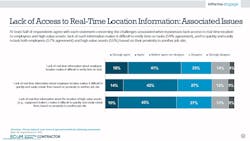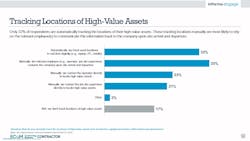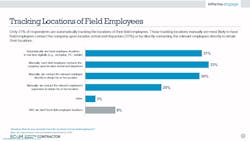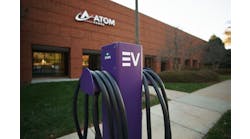We’ve all heard the importance of “location, location, location” in the real estate world. But that well-known mantra may hold similar weight in the contracting arena. Whether you’re talking about the electrical, plumbing, or HVAC industry, when a contractor has real-time information about the location, status, and performance of its employees and vehicles, that business is uniquely in a better position to maximize productivity, efficiency, and customer satisfaction. That was the clear message revealed in a recent survey, “Location Tracking: Incidence & Issues,” performed in October 2018 by Informa Engage, EC&M, Contracting Business and Contractor magazines on behalf of Verizon Connect.
Analysis of the 345 responses received found that many businesses have already invested in the mobile devices and other digital tools necessary to collect and then act on this critical information; however, a significant number are still collecting the data manually. To shed light on the latest fleet management trends in the contracting industry and better understand the big picture, let’s take a look at some of the key survey findings as they relate to access to real-time location, staffing, and asset data.
First of all, productivity continues to be a top business challenge for contractors — with more than 43% of respondents ranking it as their No. 1 challenge and 32% labeling it second. Roughly 54% of respondents currently have real-time information about the location of their field employees. About 59% have the same visibility into their vehicles, while only 40% have it for high-value assets such as trailers.
Well over half of respondents see significant value in having real-time information about the location of employees and high-value assets. In fact, more than 54% agreed or strongly agreed that without this information, they can’t quickly and easily retask employees or high-value assets based on proximity to another job site. Even more agreed or strongly agreed that this information is key for verifying an employee’s time on task.
Despite these perceptions, only 32% of respondents currently have digital tools to track asset locations in real time. The majority handle these processes manually, such as by contacting job site supervisors or having employees report when they’ve arrived or departed a job site. Among those using manual processes, 79% got the information they need immediately or within a few minutes.
When it comes to the status of employees and equipment, well over half say these tools enable them to make more informed decisions and then quickly take action. At least 30% see business benefits in information about equipment service alerts, both for proactive maintenance and for catching emerging problems before they result in expensive repairs.
When asked about their biggest safety challenges, more than 62% indicated that many of their employees work alone. Over 34% said the lack of information about employee driving habits is a top safety challenge. These responses suggest a significant opportunity to provide these businesses with lone-worker safeguards.
When asked about the businesses benefits of the digital tools that they and their employees already use, write-in responses included “help with trouble shooting,” “camera phone to send photos if needed to discuss a situation” and “video chat.” This usage suggests an emerging opportunity to provide augmented reality solutions, where a field employee can use AR glasses so a remote colleague can walk him or her through a task. This remote colleague doesn’t necessarily have to be on staff. For example, before retiring, the remote colleague could record tutorials that can be accessed on demand via AR. Digitization of their institutional knowledge helps maximize the productivity of colleagues with only a few years’ experience.
Finally, the survey also explored budgets. About 55% of respondents indicated they would be willing to pay less than $15/month per asset or per employee for a solution that provides these types of insights and capabilities. Another 30% said they’d be willing to pay between $15 and $25 per month.








